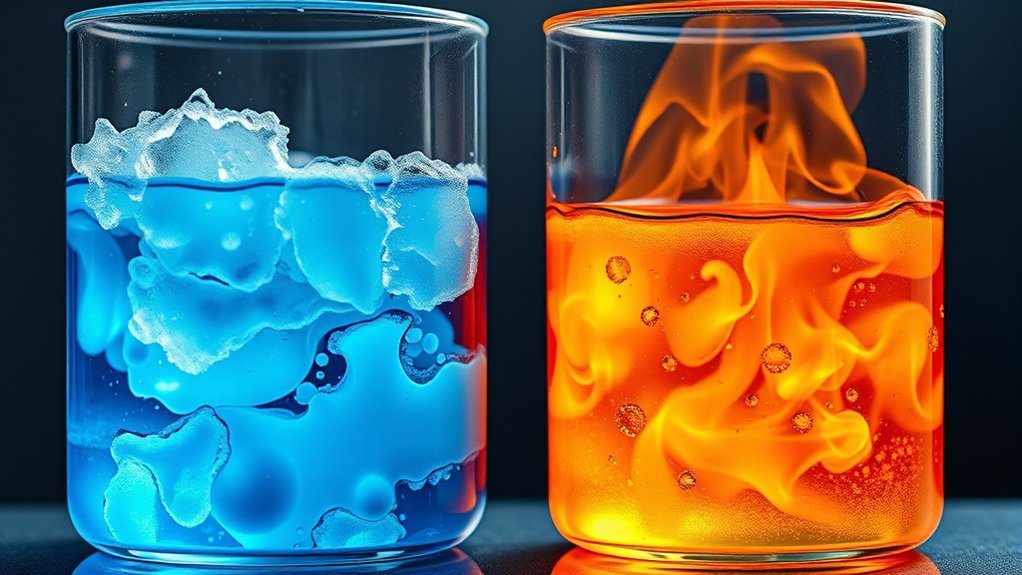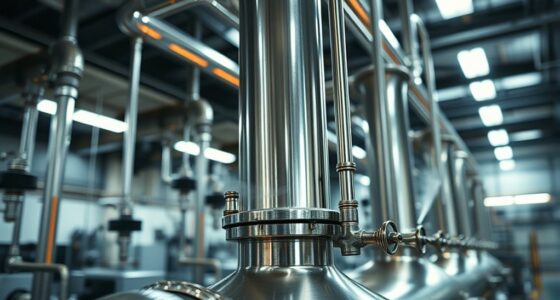Endothermic reactions absorb heat from their surroundings, causing temperatures to drop, and have a positive change in enthalpy (ΔH). Exothermic reactions release heat, raising surrounding temperatures, with a negative ΔH. These differences in heat flow affect reaction spontaneity, energy diagrams, and practical uses like cooling or heating systems. To understand how these processes work and their characteristics, keep exploring—there’s more to discover about energy flow and behavior in reactions.
Key Takeaways
- Endothermic reactions absorb heat, increasing system energy; exothermic reactions release heat, decreasing system energy.
- ΔH is positive for endothermic reactions and negative for exothermic reactions.
- Endothermic reactions cause temperature drops in surroundings; exothermic reactions cause temperature rises.
- Endothermic processes include melting and photosynthesis; exothermic include combustion and respiration.
- The main difference lies in heat flow direction: into the system for endothermic, out of the system for exothermic.
Understanding Energy Flow in Reactions

Understanding energy flow in reactions is essential to grasp how chemical processes behave. When a reaction releases heat, it’s exothermic, and heat flows from the system to the surroundings, raising the ambient temperature. Advances in neural networks have improved our ability to model and predict these energy changes more accurately. Knowing the regional differences in reaction types can also influence how we interpret energy flow in various environments.
Understanding energy flow reveals whether reactions release or absorb heat, affecting temperature and thermodynamics.
Conversely, in endothermic reactions, heat is absorbed from the surroundings, which cools the environment. You can often tell which type a reaction is by observing temperature changes: an increase indicates an exothermic process, while a decrease signals an endothermic one. This heat transfer influences the enthalpy change, which is negative for exothermic reactions and positive for endothermic ones. Remember, heat exchange is the main energy transfer method here, although some reactions may also emit light.
Understanding energy flow is crucial for predicting reaction outcomes and designing experiments. These energy flows shape the overall behavior and thermodynamics of chemical reactions.
How Endothermic Reactions Absorb Heat
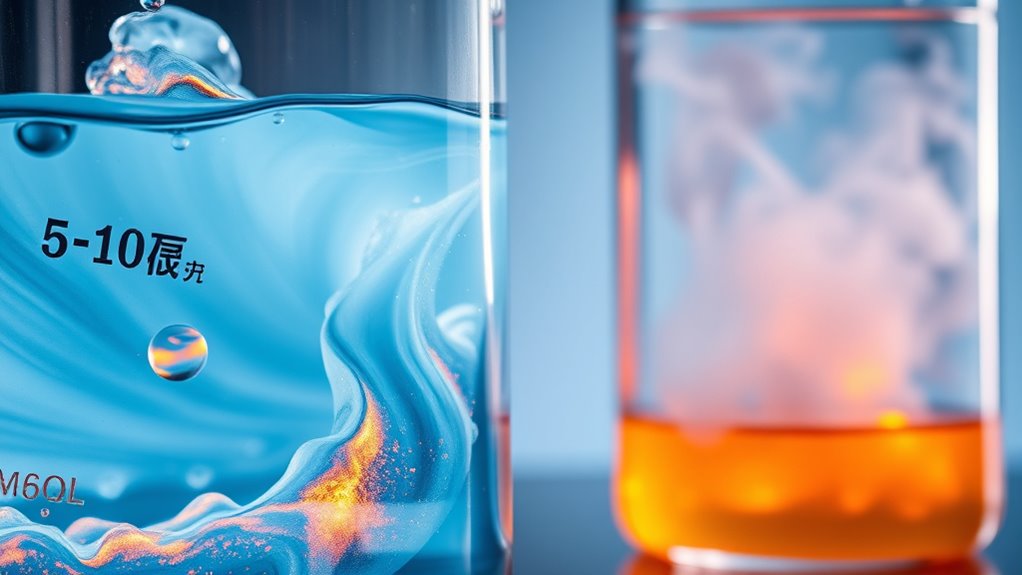
Endothermic reactions absorb heat through the transfer of thermal energy from their surroundings into the system. This energy increases the system’s internal energy or enthalpy (H).
As heat enters, it’s used to break bonds in reactants, requiring energy input from the surroundings. The products formed have higher energy than the reactants, resulting in a positive enthalpy change (ΔH > 0).
This absorption often causes a temperature rise within the system and a cooling effect in the surroundings. The absorbed heat is represented as a reactant in chemical equations, indicating energy intake.
Thermal energy stored in bonds or physical changes like melting or vaporization contributes to the overall heat absorption. This process is essential for reactions like photosynthesis, melting ice, and dissolving salts. Gold IRAs are an example of financial reactions where energy flows are involved, though in a different context. Additionally, understanding the energy transfer involved in such reactions is crucial for applications across chemistry and physics.
Characteristics of Exothermic Reactions

Exothermic reactions release energy into their surroundings, often in the form of heat, which causes a noticeable temperature increase nearby. You’ll observe this when a reaction’s products have lower energy than the reactants, leading to a negative enthalpy change ((Delta H)). The bonds formed in the products are stronger, making the overall energy lower and stabilizing the reaction. These reactions are usually spontaneous because they’ve a negative Gibbs free energy ((Delta G)). Common examples include combustion and neutralization reactions. The heat released can be harnessed for practical uses, like in engines or hand warmers. Additionally, some exothermic reactions can involve electricity, especially when coupled with galvanic cells or batteries. Proper management of heat output is crucial since uncontrolled exothermic reactions can be dangerous, potentially causing fires or explosions if not properly controlled or contained. To ensure safety and efficiency, understanding the reaction conditions is essential for managing these energetic processes effectively.
Examples of Endothermic Processes in Daily Life

Have you ever noticed how ice feels cold when it melts or how water absorbs heat during evaporation? These are classic examples of endothermic processes.
Ice melting and water evaporation are everyday examples of endothermic processes that absorb heat to change states.
When ice melts, it absorbs heat from the surroundings to break its molecular bonds, turning into water. Similarly, evaporation of water requires energy input, which it takes from the environment, to change from liquid to vapor.
Photosynthesis is another example — plants absorb sunlight to convert carbon dioxide and water into glucose and oxygen, needing energy to break bonds and form new ones. This process is driven by solar energy and highlights the importance of energy transfer in biological systems.
Even drying wet clothes is endothermic, as water molecules absorb heat to evaporate. Additionally, understanding the energy transfer involved in these processes can help us better grasp how natural systems maintain balance and temperature regulation.
These processes all depend on heat absorption, cooling their immediate environment while enabling essential natural and everyday functions.
Common Exothermic Reactions and Their Uses
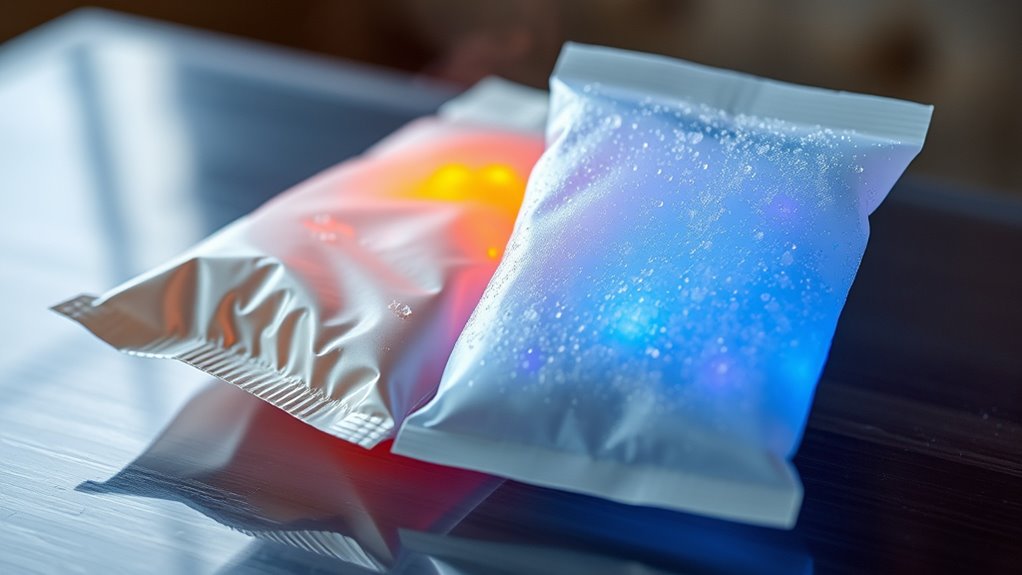
Many everyday processes release heat through exothermic reactions, which are crucial in both natural and industrial settings. You encounter combustion reactions when burning fossil fuels for energy, like in power plants or car engines, providing the power you need. Wood fires heat your home and cook food, while candles offer light and warmth.
In industry, reactions produce materials like ammonia, aluminum, and water from hydrogen and oxygen. Biological processes, such as respiration and digestion, release energy your body needs daily. Exothermic reactions are also essential in safety and medical applications, like cold packs for injuries or fireworks during celebrations.
Even in manufacturing, they help produce steel, cement, and synthetic fibers. These reactions are everywhere, powering your world and supporting essential functions.
Thermodynamic Indicators Differentiating the Two Types
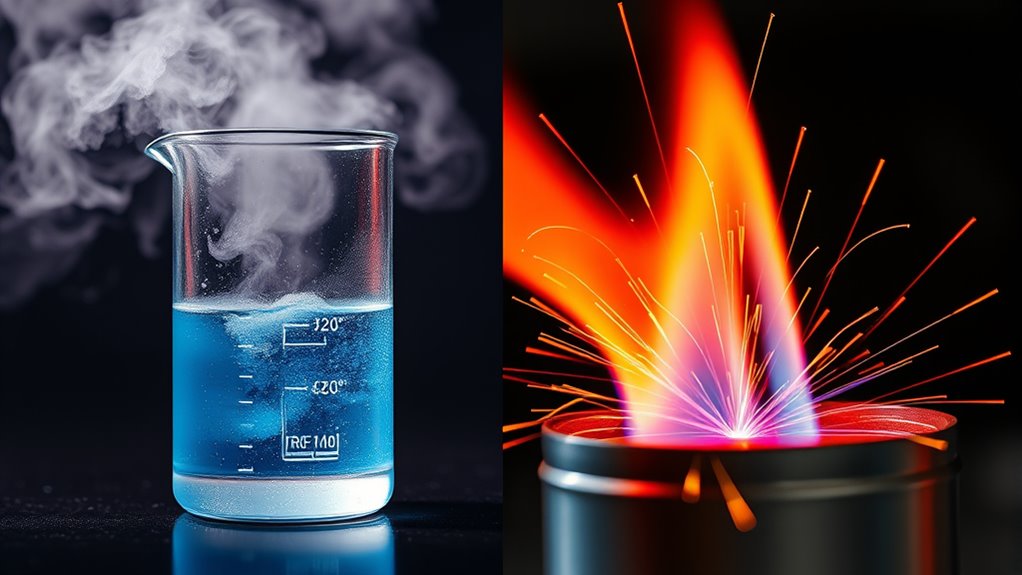
Thermodynamic indicators provide essential ways to distinguish between endothermic and exothermic reactions. The primary indicator is the sign of the enthalpy change (ΔH). Endothermic reactions have a positive ΔH, meaning they absorb heat, while exothermic reactions have a negative ΔH, releasing heat.
You can observe this through heat flow: endothermic reactions draw heat from surroundings, lowering nearby temperature, whereas exothermic reactions increase it.
Reaction equations also reflect this: energy appears as a reactant in endothermic processes and as a product in exothermic ones.
Changes in system enthalpy confirm the energy transfer direction, with endothermic reactions raising internal energy and exothermic ones lowering it.
These thermodynamic indicators, especially ΔH, are measurable and critical for reaction classification.
The Role of Entropy in Endo and Exothermic Reactions
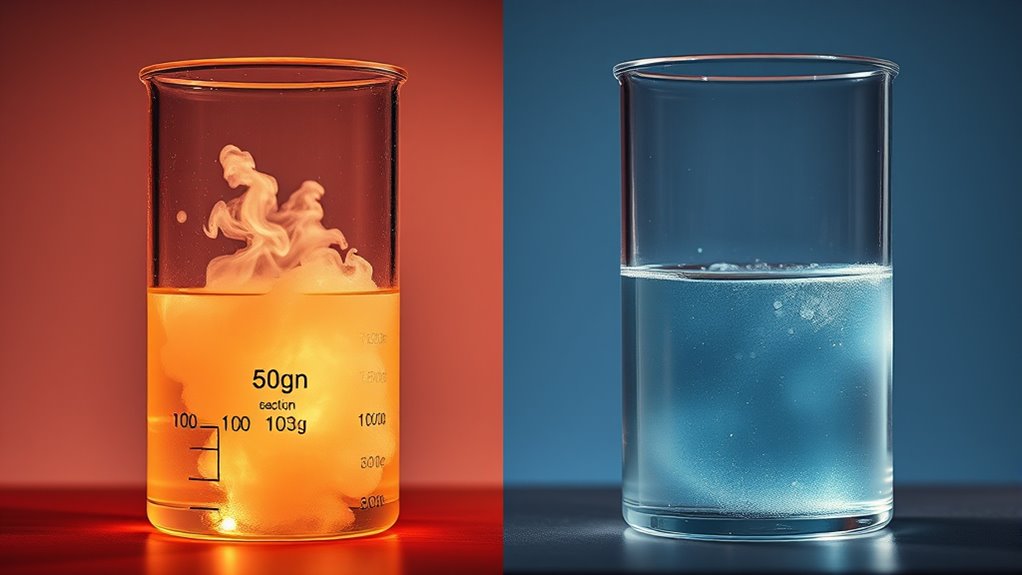
Entropy, which measures the disorder or randomness in a system, plays a pivotal role in determining whether a reaction is spontaneous.
In exothermic reactions, energy released to the surroundings increases their entropy, often making the reaction more likely to occur spontaneously. The heat transfer raises the disorder of surrounding molecules, supporting the reaction’s favorability.
Conversely, in endothermic reactions, energy is absorbed from the surroundings, decreasing their entropy. This cooling effect can hinder spontaneity unless compensated by an increase in the system’s internal entropy or other favorable conditions.
While exothermic reactions typically boost external entropy, endothermic ones may require specific circumstances, like high temperature, to offset the decrease in surroundings’ entropy and drive the reaction forward.
Practical Applications of Endothermic and Exothermic Reactions

Understanding how endothermic and exothermic reactions operate in real-world contexts reveals their significant practical uses. Exothermic reactions generate heat, making them ideal for applications like hand warmers, combustion engines, and welding with thermite.
Fireflies use exothermic reactions to produce light, while batteries rely on them to generate electricity. Conversely, endothermic reactions absorb heat, which is useful in manufacturing processes like lime production, hydrogen generation, and chemical synthesis.
They also power cooling systems such as refrigeration and play a role in water treatment. Recognizing these reactions helps optimize industrial efficiency and energy management.
Visualizing Energy Changes Through Diagrams
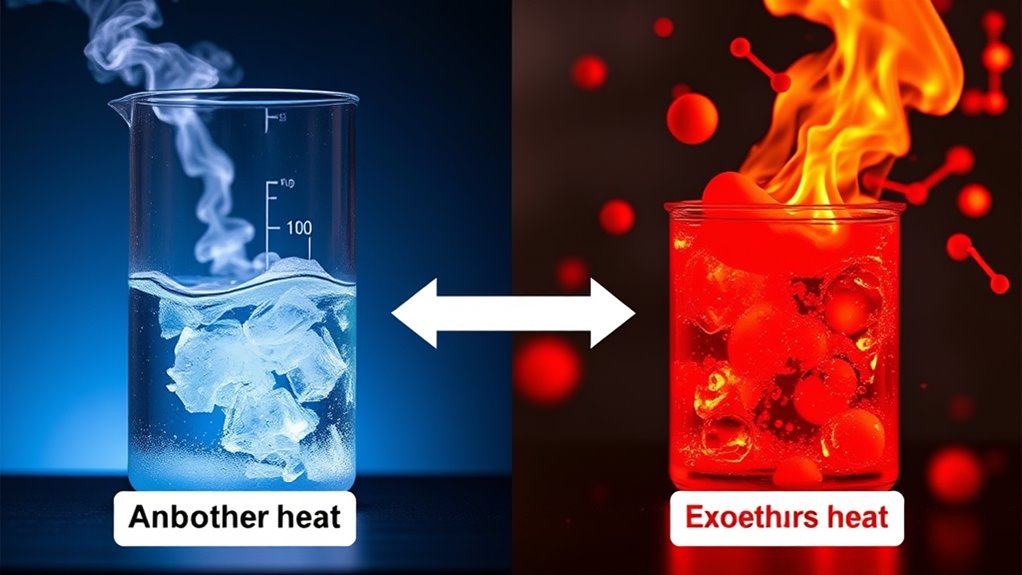
Visualizing energy changes in chemical reactions helps you understand how reactants transform into products. Energy diagrams show the system’s energy on the vertical axis and reaction progress on the horizontal axis. Reactants start on the left, and products end on the right, with energy values in units like kJ/mol.
Energy diagrams illustrate how reactants transform into products by showing energy changes during reactions.
The peak indicates the activation energy needed to reach the transition state, where bonds break and form. In exothermic reactions, products are lower in energy than reactants, releasing heat, while in endothermic reactions, products are higher, absorbing heat.
Catalysts lower activation barriers, reducing the peak height. Multi-step reactions feature valleys for intermediates, and the highest peak determines the rate.
Temperature, pressure, and catalysts influence these diagrams, helping you visualize how energy flows during reactions.
Frequently Asked Questions
How Does Temperature Influence Whether a Reaction Is Endothermic or Exothermic?
You might wonder how temperature impacts whether a reaction absorbs or releases heat. When you increase temperature, it provides energy that favors endothermic reactions, which absorb heat.
Conversely, lowering temperature tends to promote exothermic reactions that release heat. By controlling temperature, you can influence the reaction’s heat flow, shifting the equilibrium to favor either heat absorption or release, based on the reaction’s thermodynamic properties.
Can a Reaction Be Both Endothermic and Exothermic Simultaneously?
You know what they say, “You can’t have your cake and eat it too.” In reactions, a single-step process can’t be both endothermic and exothermic at the same time.
It’s like night and day—reaction energy flow is either absorbed or released, never both. Multi-step reactions may include both types, but each step remains exclusively one or the other.
What Role Does the Reaction Environment Play in Energy Flow?
You see, the reaction environment plays a vital role in energy flow by influencing conditions like temperature and pressure. When you change these, you affect how energy transfers during a reaction—either absorbing or releasing heat.
For example, higher temperatures can speed up endothermic reactions, while pressure shifts can favor certain processes.
Monitoring these environmental factors helps you understand and control energy flow, ensuring reactions proceed as desired.
How Do Catalysts Affect the Energy Profile of These Reactions?
Imagine a blacksmith forging a sword—you’re cutting through steel more easily.
Catalysts lower the activation energy for both endothermic and exothermic reactions by providing an alternative pathway.
They don’t change the energy difference between reactants and products but reduce the energy needed to start the reaction.
This speeds things up, making reactions happen faster without altering the overall energy content or thermodynamics involved.
Are Endothermic and Exothermic Reactions Reversible?
You might wonder if endothermic and exothermic reactions are reversible. The answer is yes, many of these reactions are reversible, meaning they can proceed forward and backward, reaching a dynamic equilibrium.
When they reverse, the energy flow switches—endothermic reactions absorb heat, while exothermic reactions release it. This reversible nature depends on conditions like temperature and pressure, allowing the reactions to shift direction under the right circumstances.
Conclusion
Understanding the delicate dance between endothermic and exothermic reactions helps you appreciate the world’s subtle energy exchanges. By observing these reactions, you can see how nature’s gentle touch shapes everyday life, from warmth to cooling. Embrace this knowledge as a quiet reminder of life’s constant balance, where even small changes carry profound beauty. Let this awareness inspire you to cherish the unseen forces that quietly sustain and transform our world every day.
